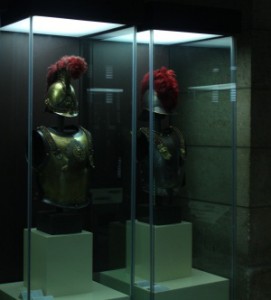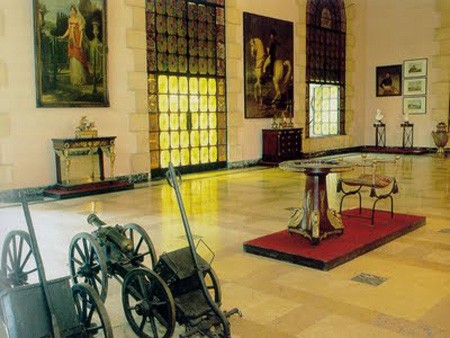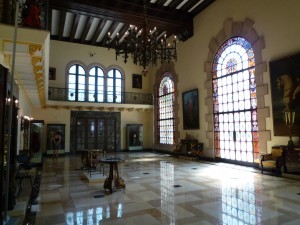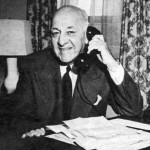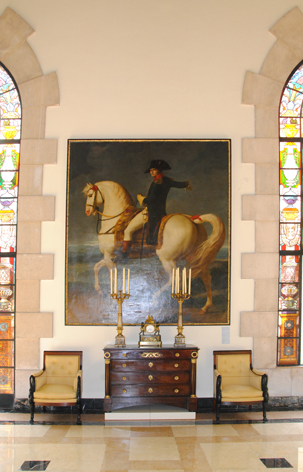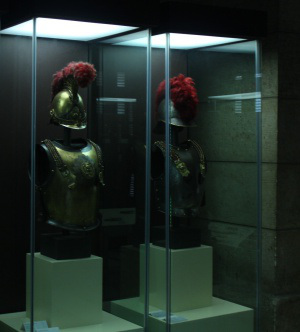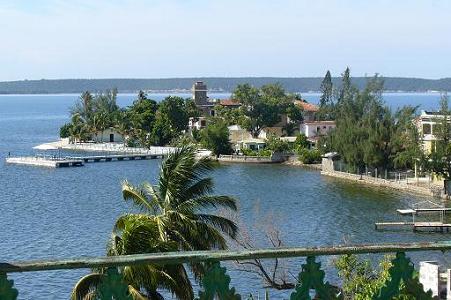WORLD EXPERTS SURPRISED AND ADMIRED BY THE “NAPOLEONIC TREASURES” IN CUBA.
The peculiar relics related to Napoleon Bonaparte and his times, preserved for decades by museums and Cuban collectors have attracted and impressed international experts gathered this week on the island to discover the hidden treasures that Cuba offers.
Scholars from France, Canada, USA, England, Poland and Russia, among other countries, traveled to Cuba to attend the event for the first time in Latin-based; including Luke Dalla Bona, a member of the International Napoleonic Society and its coordinator XII congress, which concluded this week in Havana. It surprised to them to know first hand the Napoleonic Museum of Havana, founded in 1961, following its restoration and reopening in 2011.
The director of the Napoleonic Museum, Sadys Sanchez believes that this kind of “boom” is the result of the painstaking restoration of the building and the collection process, by the Office of the Historian of Havana, which lasted five years.
The museum has a vast library and over 10,000 pieces of the Napoleonic period, which is attributed a millionaire value, including relics like the original death mask of Napoleon and the gold watch that marked the last hours of life.
Other emperor also draw attention: a jacket, the cocked hat and spyglass that used in Santa Elena, who carried two guns for shooting in Moscow in 1812, a lamp that gave Josefina, a lock of hair and a molar.
Princess Napoleon, widow of Louis Marie Bonaparte, Prince Napoleon, a descendant of King Jerome Bonaparte’s younger brother, attended in 2011 at the reopening of the museum and donated part of tableware to give “testimony of esteem” of his family for that institution.
“(The collection) is the most important in Latin America from the institutional point of view. There are private collections, but this is the most important open to the public,” said Sanchez told Efe.
HISTORY OF THE ‘NAPOLEONIC TREASURE’ IN CUBA.
Link to the Past.
Much of what displayed belonged to millionaire disappeared Julio Lobo, magnate of the sugar industry, considered the richest man in Cuba when the revolution triumphed in 1959 and spent part of his fortune to purchase parts related to Napoleon at auction houses Europe and the United States.
Although Lobo heritage is the focus of this type of collecting on the island, there are “many Napoleonic souvenirs” in other parts of the country, private collections and museums still studying with pieces that amaze researchers, told Efe historian Cuban Ernesto Alvarez.
In the province of Matanzas, says Alvarez, a fragment of the slab that covered the remains of Napoleon at St. Helena Bonaparte and a bust of the famous sculptor Antonio Canova is treasured.
Several objects bequeathed Juan Bautista Leclerc, a painter born in Matanzas and raised in France, who fled with their possessions in Europe to the island and hid in a plantation of his family to know that pieces acquired for Napoleonic collection had been stolen from cabinet of Medals King Library in Paris and the police were after them, tells Alvarez.
“There are many individuals associated with Napoleon who lived here and are still studying (…) They came to Cuba fleeing processes such as the French and Napoleonic revolutions, settled, and objects brought back memories,” he said.
The historian says that even an Imperial Guard of Napoleon died in Matanzas, and his remains were in the town museum.
From these figures, the most important was undoubtedly the Francois Antommarchi, doctor of Napoleon and who, after dying it in Santa Elena, returned to France and from there traveled to Cuba, living much of his life in Santiago de Cuba, where his descendants still exist, going later to Havana where he settled to study the yellow fever, of which he died.
“With him brought relics that belonged to Napoleon himself,” says Sánchez Sadys, including the famous first death mask which he drew up and then be reproduced several times.
Sanchez believes that Cuba experts have ahead several lines of research, especially to shed light on the links between Napoleon and formed the island through other people.
A real treasure on the life of the great Corsican and largely unknown by the world of their existence.
Agencia/ EFE/Anett Ríos/Excerpts/Internet Photos/Arnoldo Varona/TheCubanHistory.com
THE CUBAN HISTORY,HOLLYWOOD.
FOLLOW US ON TWITTER AND FACEBOOK. THECUBANHISTORY.COM
SORPRENDE EXPERTOS MUNDIALES LOS “TESOROS NAPOLEÓNICOS” EN CUBA.
Las peculiares reliquias relacionadas con Napoleón Bonaparte y su época, conservadas desde hace décadas por museos y coleccionistas cubanos, han atraído y entusiasmado a expertos internacionales reunidos esta semana en la isla para descubrir los tesoros ocultos que Cuba les ofrece.
Estudiosos de Francia, Canadá, EE.UU., Inglaterra, Polonia y Rusia, entre otros países, viajaron a Cuba para asistir al evento -por primera vez con sede en América- entre ellos Luke Dalla Bona, miembro de la Sociedad Napoleónica Internacional y coordinador de su XII congreso, que concluyó en La Habana. Conocer el Museo Napoleónico de La Habana, creado en 1961, a raíz de su restauración y reapertura en 2011.
La directora del Museo Napoleónico, Sadys Sánchez, cree que esta especie de “boom” es fruto de la minuciosa restauración del inmueble y la colección, un proceso, a cargo de la Oficina del Historiador de La Habana, que duró cinco años.
El museo posee una vasta biblioteca y más de 10.000 piezas del periodo napoleónico, a las que se atribuye un valor millonario, incluidas reliquias como la mascarilla mortuoria original de Bonaparte y el reloj de oro que marcó sus últimas horas de vida.
Otros objetos del emperador también llaman la atención: una casaca, el bicornio y el catalejo que usó en Santa Elena, dos pistolas que portó durante la toma de Moscú en 1812, una lámpara que obsequió a Josefina, un mechón de cabellos y un molar.
La princesa Napoleón, viuda de Luis Marie Bonaparte, príncipe Napoleón, a su vez descendiente del rey Jerome, el hermano menor de Bonaparte, asistió en 2011 a la reapertura del museo y donó parte de una vajilla para dar “testimonio de la estima” de su familia por esa institución.
“(La colección) es la más importante en América Latina desde el punto de vista institucional. Existen colecciones privadas, pero esta es la más importante abierta al público”, aseveró a Efe Sánchez.
GLORIOSO PASADO DE COLECCIONISTAS CUBANOS.
HISTORIA DEL ‘TESORO NAPOLEONICO’ EN CUBA.
Buena parte de lo exhibido perteneció al desaparecido millonario Julio Lobo, magnate de la industria azucarera, considerado el hombre más rico de Cuba cuando triunfó la revolución en 1959 y que dedicó parte de su gran fortuna a adquirir piezas relacionadas con Napoleón en casas de subasta de Europa y Estados Unidos.
Aunque el patrimonio de Lobo es el eje central de este tipo de coleccionismo en la isla, existen “muchos recuerdos napoleónicos” en otras partes del país, colecciones privadas y museos aún por estudiar con piezas que sorprenden a los investigadores, comentó a Efe el historiador cubano Ernesto Álvarez.
En la provincia de Matanzas, explica Álvarez, se atesora un fragmento de la losa que cubrió los restos de Napoleón en Santa Elena y un busto de Bonaparte del famoso escultor Antonio Cánova.
Varios objetos los legó Juan Bautista Leclerc, un pintor nacido en Matanzas y criado en Francia, que huyó con sus posesiones de Europa a la isla y se escondió en un cafetal de su familia al saber que piezas adquiridas para su colección napoleónica habían sido robadas del Gabinete de Medallas de la Biblioteca del Rey en París y la policía estaba tras ellas, relata Álvarez.
“Hay muchas personalidades vinculadas con Napoleón que vivieron aquí y están todavía por estudiar (…) Vinieron a Cuba huyendo de procesos como las revoluciones francesa y napoleónica, se establecieron, trajeron recuerdos y objetos”, afirmó.
El historiador asegura que incluso un guardia imperial de Napoleón murió en Matanzas, y sus restos aparecieron en el museo de la ciudad.
De esas figuras, la más importante fue sin duda la de Francois Antommarchi, médico de cabecera de Napoleón y quien, tras morir éste en Santa Elena, regresó a Francia y de ahí viajó a Cuba, viviendo gran parte de su vida en Cuba en la ciudad de Santiago de Cuba, donde todavía existen descendientes de el, yendo más tarde a la Habana donde se radicó para estudiar la fiebre amarilla, enfermedad de la que murió.
“Con él trajo reliquias que pertenecieron al propio Napoleón”, destaca Sadys Sánchez, incluida la famosa primera mascarilla mortuoria que él mismo confeccionó y que después sería reproducida varias veces.
Sánchez cree que en Cuba los expertos tienen por delante varias líneas de investigación, sobre todo para arrojar luz sobre los vínculos que se formaron entre Napoleón y la isla a través de otras personas.
Todo un tesoro sobre la vida del gran corso y en gran parte desconocido por el mundo de su existencia.
Agencia/ EFE/Anett Ríos/Excerpts/Internet Photos/Arnoldo Varona/TheCubanHistory.com
THE CUBAN HISTORY,HOLLYWOOD.







